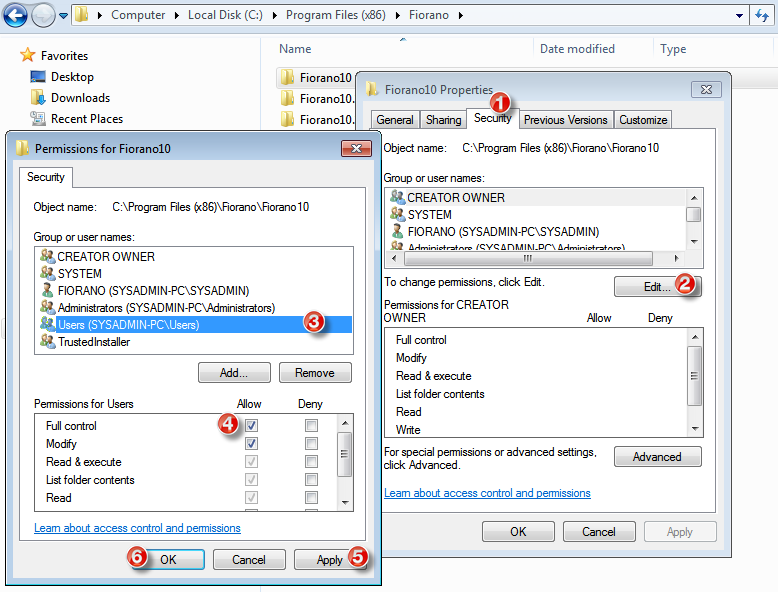This page explains the configuration files which are used to manage and configure Fiorano Servers for a particular environment, and also provides links to the sections which give a better idea about the configuration.
Server Configuration
Fiorano Servers are pre-configured to run on a single System.
Providing Permissions on Windows Servers
For Fiorano platform to work flawlessly and efficiently, the installer directory needs to have Administrator privileges. To grant permissions to specific/all users:
- Go to the directory where Fiorano Platform is installed.
- Right-click the FIORANO_HOME directory and click Properties.
- Go to the Security tab and click Edit.
- Select the desired user and then enable the Allow check box against the Full Control option present under the Permissions for Users section.
- Click Apply and click OK to grant permission.

Properties and Security settings for FIORANO_HOME
Turning Off or Excluding Fiorano Processes from Antivirus Checks
Fiorano Servers access various files present in the installation directory. For a seamless execution of various processes, Fiorano recommends excluding FIORANO_HOME from antivirus checks.
Fiorano uses a set of fixed default ports that needs to be allowed through the server firewall for Fiorano Servers to interact with each other. These ports are specified within the server profiles.
The specific ports (default) that need to be allowed on the server are:
Fiorano Enterprise Server Default Ports | |
|---|---|
| Port Number | Port Name |
| 2047 | RMI Communications |
| 1947 | External RTL Communications |
| 1948 | HA Secondary External RTL Communications |
| 2048 | RMI HA Secondary |
| 1980 | Enterprise Server Dashboard |
| 1847 | Internal calls |
| 1848 | Internal calls HA Secondary |
Fiorano Peer Server Default Ports | |
|---|---|
| Port Number | Port Name |
| 2067 | RMI Communications |
| 1867 | Internal calls |
| 1868 | HA Secondary Internal calls |
| 2068 | RMI HA Secondary |
| 1880 | Peer Web Server |
JVM Configuration File
Each script is associated with a specific configuration (conf) file ideally in the same location as the script file, with its name the same as that of the script file followed by the .conf extension. This configuration file provides various configuration properties of server/tools as shown below:
| Config Property/Block | Usage |
<java.classpath> | Specify any additional jar files required to be present in the classpath in a separate line at the end of this block. |
<java.endorsed.dirs> | Specify the jars other than the default jars to be considered in a separate line at the end of this block. |
<java.ext.dirs> | Specify the external jar files to be loaded along with the default system jars, in a separate line as the end of the block. |
<java.library.path> | Specify the folders containing dll/so files that are to be loaded in a separate line at the end of the block. |
<java.system.props> | Specify any additional system properties, in separate a line at the end of the block. |
<jvm.args> | Specify any arguments to JVM such as memory settings and debug info in a separate line at the end of the block. |
Profile Configuration
The Profile Management perspective in eStudio can be used for Offline configuration of Fiorano profiles.
HA Configuration
High Availability (HA) Servers maximize system availability and eliminate any single point of failure.